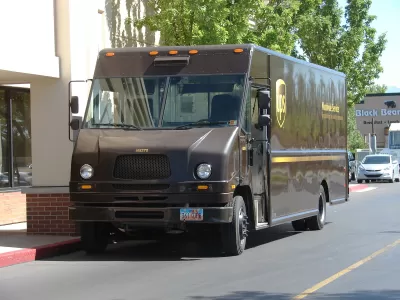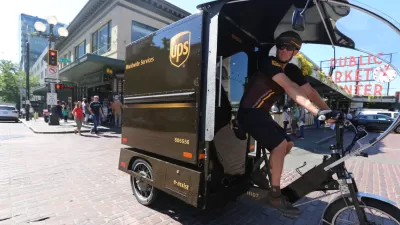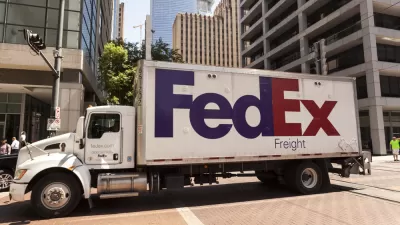How cities can minimize the impact of delivery vehicles on air quality and congestion through effective curb management and zero-emission delivery zones.

As urban delivery services become more common for a wider variety of goods and services, cities are looking at ways to cut down on the emissions and congestion caused by delivery vehicles. Writing in The City Fix, Hamilton Steimer and Vishant Kothari outline the results of a paper from the World Resources Institute (WRI) that assesses efforts to create ‘zero-emission delivery’ zones in the United States and the Netherlands.
As the article explains, “Zero-emission delivery zones are areas in which only zero-emission vehicles have unrestricted access, with fossil fuel vehicles either prohibited from entry or required to pay a fee for access.” The zones can take a variety of forms, from voluntary zones to localized pick-up locations and curbside spaces reserved for ZEVs.
The authors provide detail on the city of Los Angeles’ zero-emission commercial loading zones, which regulate curbside management in five dense areas with high demand for commercial loading and high levels of air pollution. “If expanded, zero-emission loading zones could discourage fossil fuel vehicle use in specific areas, incentivize a shift to zero-emission delivery throughout Los Angeles, and reduce residents’ exposure to air pollutants like particulate matter and nitrous oxides.”
The paper also provides five recommendations for developing and implementing zero-emission delivery zones successfully. As the authors caution, “Without proper design and implementation, zero-emission delivery zones and supportive policies could exacerbate existing inequities, such as diverting polluting freight traffic through neighborhoods outside the zone or failing to supply small businesses in the zone with the necessary financial support to purchase ZEVs.”
FULL STORY: Zero-Emission Delivery Zones: A New Way to Cut Traffic, Air Pollution and Greenhouse Gases

Planetizen Federal Action Tracker
A weekly monitor of how Trump’s orders and actions are impacting planners and planning in America.

Restaurant Patios Were a Pandemic Win — Why Were They so Hard to Keep?
Social distancing requirements and changes in travel patterns prompted cities to pilot new uses for street and sidewalk space. Then it got complicated.

Maui's Vacation Rental Debate Turns Ugly
Verbal attacks, misinformation campaigns and fistfights plague a high-stakes debate to convert thousands of vacation rentals into long-term housing.

In California Battle of Housing vs. Environment, Housing Just Won
A new state law significantly limits the power of CEQA, an environmental review law that served as a powerful tool for blocking new development.

Boulder Eliminates Parking Minimums Citywide
Officials estimate the cost of building a single underground parking space at up to $100,000.

Orange County, Florida Adopts Largest US “Sprawl Repair” Code
The ‘Orange Code’ seeks to rectify decades of sprawl-inducing, car-oriented development.
Urban Design for Planners 1: Software Tools
This six-course series explores essential urban design concepts using open source software and equips planners with the tools they need to participate fully in the urban design process.
Planning for Universal Design
Learn the tools for implementing Universal Design in planning regulations.
Heyer Gruel & Associates PA
JM Goldson LLC
Custer County Colorado
City of Camden Redevelopment Agency
City of Astoria
Transportation Research & Education Center (TREC) at Portland State University
Camden Redevelopment Agency
City of Claremont
Municipality of Princeton (NJ)




























